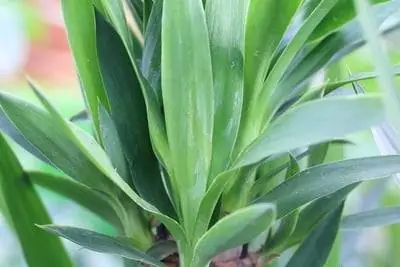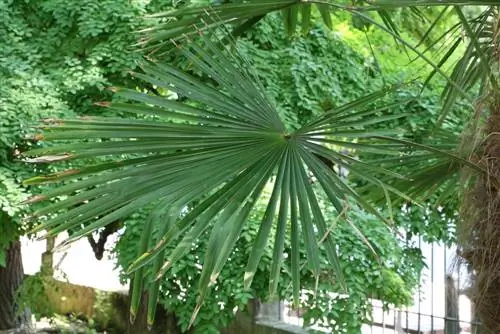- Author admin [email protected].
- Public 2023-12-17 03:39.
- Last modified 2025-06-01 06:48.
The fan palm is a tree that has its origins in the hot Mediterranean countries. Its fan-shaped ribbed leaves with silky, hanging leaf fibers make this palm an effective indoor and garden plant. If care is taken during the growth and rest phases, it also thrives well in the northern, colder regions.
Plants
Washingtonia robusta and Washingtonia filifera as well as Trachycarpus fortunei belong to the fan palm genus. Its dark brown bast trunk stands in pleasant contrast to the lush green, large leaves. The ribbed fronds split at the leaf edges and have long fibers at the rib tips. Some species have strong thorns on the edges of the strong leaf stems, which can potentially cause serious injuries to the hands and arms. In southern and subtropical countries, mature trees reach a height of 10 - 15 meters.
Sowing and soil conditions
It reproduces by sowing seeds, which sprout and thrive in a mixture of peat and compost with the addition of gravel, sand and lava granules. The seeds are released in late summer to autumn and, with a little luck, will begin to germinate in the spring of the following year. The substrate should only be kept moist during the germination phase. Waterlogging would cause the seedlings to rot and all work would be destroyed. If you don't want to go to the trouble, buy small, ready-grown plants.
Location and temperature
Like almost all types of palm trees, Washingtonia also needs a bright, sunny location. It loves temperatures of 20 - 25 °C and tolerates direct sunlight. The fan palm can be safely brought outdoors in summer. Enough sunlight will allow it to sprout new, fresh, juicy green fronds within a short period of time. If the location is too dark, it will drop its lower fronds and wither. The fan palms are generally considered robust and winter-proof.
Wintering
They can survive low temperatures down to -8°C for a short time. Despite everything, the fan palm should be well protected against the cold if it is to remain outdoors in winter. Young plants in particular do not yet have the long roots necessary to reach the frost-proof area of the soil. The small roots freeze and the palm dies. During hibernation, the young palm tree needs less light and can be protected from temperatures that are too low with a large, airy sack and Steropur sheets if it is to remain outdoors. It is important that the palm heart is protected from winter moisture. Mulch placed on the ground around the trunk helps keep the ground warm and prevents ground frost. The fronds are tied high with a thin rope. Then the bag is pulled over the leaves up to the trunk and tied together at the bottom. The hard foam panels are placed around the palm trunk and also tied together. In light frost, a bamboo mat around the trunk can also help.
It is important that there is enough air circulation in the leaves, as water evaporates through the fronds even in winter. The indoor palm should not be too warm even in winter. The heating air dries out the fronds too much. A bowl of water provides a quick remedy here, and the increased humidity also promotes the growth of the fronds. Even in the winter months, the palm tree prefers sunny, bright locations.
Repotting

Repotting young trees should be done in early spring so that the palm tree can recover at the beginning of the growth phase. The fresh substrate, consisting of peat, the base made from compost, a mixture of gravel and sand in equal parts, lava granules or expanded clay help the plant to grow lushly. The old ball of soil should not be knocked off but incorporated into the new soil, otherwise unnecessary air holes will arise between the roots, which prevent the substance from being absorbed. The new pot should be a few sizes larger than the old one so that it has enough opportunities to develop. It is also important to make sure that the pot is high, as the roots grow vertically into the soil. When they push out of the top soil, it's high time to change the bucket.
Pouring
- The fan palm needs a lot of water, especially in the growing months, in spring.
- But here too, the dreaded waterlogging, which leads to rotting of the roots, must be avoided.
- The soil should be kept moist. Too much watering washes nutrients and minerals out of the substrate.
- Natural clay pots offer the plant sufficient air and water circulation for the soil and roots.
- A humidifier serves the indoor palm well in the hot and dry summer months and ensures that the fans are always green.
Fertilize
Fertilizing the fan palm generally starts in the spring months and ends at the end of summer. A complete fertilizer should be used that sufficiently supports the palm tree's growth. The plant needs nitrogen in nitrate form to form new shoots and leaves and to form chlorophyll. Phosphorus, in the form of phosphates and phosphoric acid, increases the development of strong and he althy roots. The plant needs potassium for good stability and for the growth of fruits and flowers.
Cutting
Pruning palm trees in northern areas should generally be done before cold periods or immediately after. Only those leaves that are tipped below the horizontal line, dry and old, brown fronds are trimmed. This avoids excessive pruning, which would affect the plant's growth as it absorbs sunlight and moisture through the fronds. The trunk of the palm tree must also be freed from the old stumps of the stems, as unnecessary moisture and parasites settle in the compartments. Be careful of thorns, especially when pruning.
Diseases and pests
The palm trees are often attacked by scale insects, which can easily be overlooked due to their good camouflage color. They have a flat, convex chitinous shell that allows them to rock slightly as they walk. There are several types of scale insects, including the scale insects, the scale insects, the mealybugs and the mealybugs. They anchor their proboscis firmly into the leaves of the host plant and suck out the sap. The saliva they put into the wound site is poisonous.
What you should know about the fan palm in brief
Although palm trees generally grow very slowly, the fan palm is one of the species that can grow into stately specimens relatively quickly. It is one of the palm species that can withstand some frost and can therefore - at least in mild regions - be planted completely outside. The fan palm can also be kept very well in pots. It is important to make sure that you plant the palm tree in a relatively high pot/pot as it forms taproots. Their water needs are moderate. The root ball should be kept moist, but by no means wet. In summer on the terrace the plant enjoys a sunny and, above all, warm location, which you should slowly get used to.
- For the first few weeks of freedom, it should be in partial shade and protected.
- If you want to overwinter the palm tree indoors, a relatively bright but cool room is suitable.
- Temperatures around 5-10 °C are ideal for wintering.
- Fan palms that are left outside during the summer should under no circumstances be kept in a warm room over the winter.
- Due to the dry heating air, warmth but significantly less light than in summer, the fan palm does not survive long despite spraying.
- If the palm tree stays outside in the pot in winter, you should put it in a protected place for the winter.






